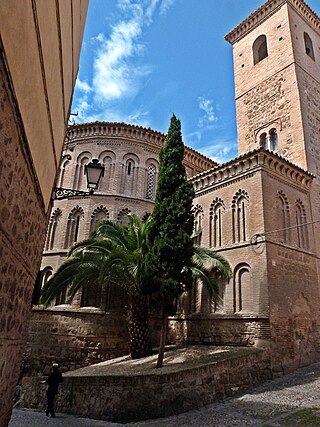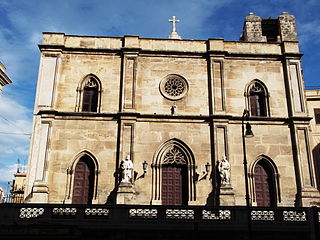
San Michele Arcangelo is a Roman Catholic church located on Largo San Gianuario, in front of the more imposing church of San Gianuario in the town of Marsico Nuovo, province of Potenza, region of Basilicata, Italy.

San Michele Arcangelo is a Roman Catholic church located on Largo San Gianuario, in front of the more imposing church of San Gianuario in the town of Marsico Nuovo, province of Potenza, region of Basilicata, Italy.
The popularity of churches dedicated to the warrior angel was spread by the Lombards, and this and some documents attest to this church existing centuries before 1131, perhaps in the time of the Duchy of Benevento. The church at the site has undergone many reconstructions over the centuries. Many are due to damage by earthquakes, including one in 1700 cited by a plaque in the belltower.
The present facade was likely the original apse. The main portal in gothic-style dates to the 13th century or earlier, and is attributed to the Master Melchiorre da Montalbano.
The interior has a medieval stone baptismal font and an 18th-century painting on wood of the Archangel. The apse has remains of medieval frescoes showing Byzantine influence. [1]

Romanesque architecture is an architectural style of medieval Europe that was predominant in the 11th and 12th centuries. The style eventually developed into the Gothic style with the shape of the arches providing a simple distinction: the Romanesque is characterized by semicircular arches, while the Gothic is marked by the pointed arches. The Romanesque emerged nearly simultaneously in multiple countries ; its examples can be found across the continent, making it the first pan-European architectural style since Imperial Roman architecture. Similarly to Gothic, the name of the style was transferred onto the contemporary Romanesque art.

A mosaic is a pattern or image made of small regular or irregular pieces of colored stone, glass or ceramic, held in place by plaster/mortar, and covering a surface. Mosaics are often used as floor and wall decoration, and were particularly popular in the Ancient Roman world.

Arezzo is a city and comune in Italy and the capital of the province of the same name located in Tuscany. Arezzo is about 80 kilometres southeast of Florence at an elevation of 296 metres (971 ft) above sea level. As of 2022, the population was about 97,000.

Cathedrals, collegiate churches, and monastic churches like those of abbeys and priories, often have certain complex structural forms that are found less often in parish churches. They also tend to display a higher level of contemporary architectural style and the work of accomplished craftsmen, and occupy a status both ecclesiastical and social that an ordinary parish church rarely has. Such churches are generally among the finest buildings locally and a source of regional pride. Many are among the world's most renowned works of architecture. These include St Peter's Basilica, Notre-Dame de Paris, Cologne Cathedral, Salisbury Cathedral, Antwerp Cathedral, Prague Cathedral, Lincoln Cathedral, the Basilica of Saint-Denis, Santa Maria Maggiore, the Basilica of San Vitale, St Mark's Basilica, Westminster Abbey, Saint Basil's Cathedral, Antoni Gaudí's incomplete Sagrada Família and the ancient cathedral of Hagia Sophia in Istanbul, now a mosque.

Byzantine architecture is the architecture of the Byzantine Empire, or Eastern Roman Empire, usually dated from 330 AD, when Constantine the Great established a new Roman capital in Byzantium, which became Constantinople, until the fall of the Byzantine Empire in 1453. There was initially no hard line between the Byzantine and Roman Empires, and early Byzantine architecture is stylistically and structurally indistinguishable from late Roman architecture. The style continued to be based on arches, vaults and domes, often on a large scale. Wall mosaics with gold backgrounds became standard for the grandest buildings, with frescos a cheaper alternative.

Teggiano, formerly Diano, is a town and comune (municipality) in the province of Salerno, Campania, Italy. It is situated on an isolated eminence above the upper part of the valley to which it gives the name of Vallo di Diano.

Marsico Nuovo is a town and comune of the province of Potenza in the Basilicata region of southern Italy. It was the seat of the bishops of Grumentum.

Cirié is a comune (municipality) in the Metropolitan City of Turin in the Italian region Piedmont, located about 20 kilometres (12 mi) northwest of Turin.

The basilica of San Nazaro in Brolo or San Nazaro Maggiore is a 4th-century Roman Catholic church in Milan, region of Lombardy, Italy.

Italy has the richest concentration of Late Antique and medieval mosaics in the world. Although the art style is especially associated with Byzantine art and many Italian mosaics were probably made by imported Greek-speaking artists and craftsmen, there are surprisingly few significant mosaics remaining in the core Byzantine territories. This is especially true before the Byzantine Iconoclasm of the 8th century.

Longobards in Italy: Places of Power is seven groups of historic buildings that reflect the achievements of the Germanic tribe of the Lombards, who settled in Italy during the sixth century and established a Lombard Kingdom which ended in 774 A.D.

The Duomo Vecchio or Old Cathedral is a Roman Catholic church in Brescia, Italy; the rustic circular Romanesque co-cathedral stands next to the Duomo Nuovo of Brescia. It is officially known as the Winter Co-Cathedral of Santa Maria Assunta, while the adjacent main cathedral is known as the Summer Cathedral.

The Cathedral of San Gerardo is the main church or duomo of the city of Potenza, capital of the province of the same name, and of the region of Basilicata, Italy. Since 1986 Potenza forms part of the archdiocese of "Potenza-Muro Lucano-Marsico Nuovo".

Marsico Nuovo Cathedral is a Roman Catholic cathedral, dedicated to the Assumption of the Virgin Mary and Saint George, in the town of Marsico Nuovo, province of Potenza, region of Basilicata, Italy. It stands on a hill that rises above the town. Formerly the seat of the diocese of Marsico Nuovo, it has been a co-cathedral within the Archdiocese of Potenza-Muro Lucano-Marsico Nuovo since 1986.

San Gianuario is a Roman Catholic church located on Largo San Gianuario, in front of the church of San Michele Arcangelo, in the town of Marsico Nuovo, province of Potenza, region of Basilicata, Italy. It is cited as the co-cathedral of the town along with the church of San Giorgio.
The Chiesa della Madonna del Carmine is a Roman Catholic church located on Via Raia Occidentale in the town of Marsico Nuovo, province of Potenza, region of Basilicata, Italy.
Melchiorre da Montalbano was an Italian architect and sculptor, active in the 13th century in the region of Basilicata.

The Church of San Bartolomé is a medieval building in Toledo, in Castile-La Mancha, Spain. It is located in the southern part of the walled city, at the corner of calle San Bartolomé and calle Cristo de la Para, a few hundred meters south-west of the Cathedral of Santa María.

Sant'Antonio Abate is a Gothic-style Roman Catholic parish church located on Via Roma #203A in the ancient quarter of Castellammare, in central Palermo, region of Sicily, Italy. The church sits at the west corner of the Vucciria market.